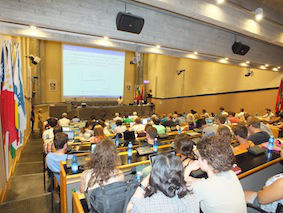Speaker
Description
Abstract: Modern scientific balloons are capable of lifting payloads weighing up to about 2000 kg to altitudes of approximately 36 km, within 0.5% of the top of the atmosphere. The basic balloon technology was developed in the 1950s as a form of very-high-altitude, difficult to detect “spy aircraft”. Today, The NASA Scientific balloon program conducts flights from the continental US, Antarctica, Australia, Sweden, and recently New Zealand. From Antarctica, conventional “zero-pressure” balloons routinely fly for 30 days and in 2012, the SuperTIGER instrument flew for 55 days, the record for heavy scientific flights. A new “superpressure” balloon (SPB) developed by NASA shows promise of even longer flights even at mid-latitude. Balloons have been exceptionally important in Cosmic Ray research, and most direct measurements of galactic cosmic rays (GCR) have been made by balloon-borne instruments. Here a brief introduction to the history and current capability of the scientific balloon program, as well as practical comments on balloon payloads will be given, together with comments on emerging capabilities.

